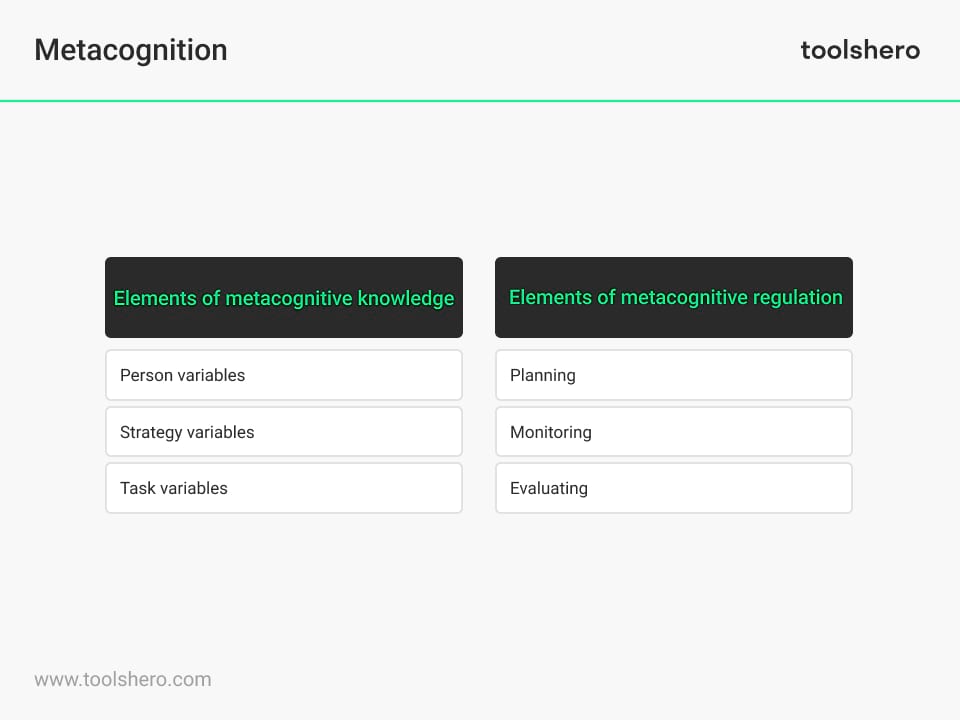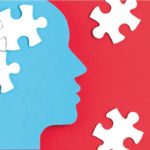Metacognition explained

Metacognition: this article explains Metacognition in a practical way. After reading, you’ll understand the basics of this powerful psychological tool and human thinking method. This article contains a general definition of the concept, as well as examples, strategies and tips. Enjoy reading!
What is Metacognition?
Metacognition is ‘thinking about thinking’, ‘knowing about knowing’ and ‘becoming aware of awareness’. The term comes from the root word meta, which means further or on top of.
It takes many forms and includes knowledge about when and how certain strategies can be used to solve problems or to learn. In general, metacognition involves two components: knowledge about cognition and regulation of cognition.
Metacognition as a concept was first introduced by John Flavell. He is seen as the founder of this field within psychology. In answer to the question: “What is metacognition?” Flavell stated that metacognition is the knowledge people have about their own cognitive processes.
Research shows that individuals engage in monitoring and control of their cognitive tasks.
By actively reflecting on their own thinking, individuals can gain insights into their strengths and weaknesses, leading to enhanced learning and problem-solving abilities.
Through metacognition, individuals can monitor their understanding, evaluate their performance, and make adjustments accordingly. Ongoing research on metacognition sheds light on the intricate processes involved in self-regulation and self-awareness, offering valuable insights into how individuals can optimize their learning and cognitive performance.
John Flavell shares an example: “I engage in metacognition when I have more difficulty learning A than B and when I have to check C again before accepting it as fact”. It is therefore the ability to control thought processes by using various strategies. Examples of these strategies are organising, monitoring and adjusting.
In addition, metacognition is the ability to think about tasks, processes and conditions that are required in intercultural interactions.
To apply this is considered an essential part of learning successfully. It is directly linked to the self-regulation and self-reflection of strengths and weaknesses and the strategies a person devises to achieve a goal.
Metacognition is the foundation of culturally intelligent leadership because it underscores how someone thinks about a problem or situation and what strategies he or she will use to tackle the problem.
Metacognition psychology definition
Metacognition in psychology can hold the same definition as psychologist Flavell’s concept. Alternatively, the definition of metacognition can be: a deeper level of thinking. In this sense, a metacognition definition can be expanded to: your understanding of and your influence on your thinking. This includes the way you shape, change, control and adapt your thought processes.
Metacognition refers to all ways in which we regulate our own thinking. The ways in which we regulate thinking are used in learning to evaluate and enhance our own understanding and learning process.

Figure 1 – Elements of Metacognition
Metacognition: elements of metacognitive knowledge
As described, Flavell distinguishes between metacognitive knowledge and metacognitive regulation.
Metacognitive knowledge refers to what individuals know about their own metacognitive processing, about different approaches that can be used for problem solving, and about the requirements and conditions for successfully completing a task.
Metacognitive regulation mainly refers to the adjustments that individuals make in their cognitive processes to help manage and improve their learning.
Examples include plans, information management, evaluation of progress and SMART Goals, etc. Metacognitive knowledge is further divided into three categories.
1. Person variables
A person variable is what someone knows about his or her strengths and weaknesses in learning and processing information.
2. Strategy variables
Strategy variables are the strategies that a person is always ready to apply in various ways to accomplish a task.
Examples include activating prior knowledge before studying a technical article, using a glossary to look up unfamiliar words, or realising that a paragraph has to be read multiple times to be understood.
3. Task variables
Task variables are everything someone knows about the nature of a particular task and the requirements to perform the task. An example of this is the knowledge that reading an academic article takes more effort to understand and remember than any passage from a novel.
Livingston gave his own definition of metacognitive knowledge in 1997 by describing these variables: ‘I know that I (person variable) have trouble with word problems (task variable), so I will answer the math problems first and save the language problems for last.
Metacognition: Elements of metacognitive regulation
Like metacognitive knowledge, metacognitive regulation also includes some conditions or metacognitive skills that are essential.
1. Planning
Planning refers to the selection of strategies and allocation of resources that influence the task performance. Selecting good strategies and proper allocation of resources is a sign of accurate planning in the metacognitive regulation process.
2. Monitoring
Monitoring refers to an individual’s awareness of understanding and task performance. They monitor their learning as a process step of their metacognitive strategy.
3. Evaluate
Evaluation refers to assessing the end product of a particular task. The efficiency with which the task has been performed is also assessed.
Metacognition and metacognitive strategies
Below are some effective strategies for advancing metacognitions.
Self-questioning in metacognition
Self-questioning is the evaluation process that students and others can use in which they ask themselves effective questions before, during and after learning to test their understanding of what is learned.
Encouraging students to do this can be an effective way to expand their understanding of the subject. This metacognitive strategy has been extensively tried and tested.
One of the studies investigated whether self-questioning affected exactly how much the students could learn in a period. Several groups were created.
The first group asked themselves these questions during the lecture. Students in the next group asked themselves questions during the lecture and had a Q&A session with each other afterwards.
The third group of students discussed the content of the lecture in a small group, and the students from the last group of students assessed the material individually.
The researchers found that the students in the first two groups performed better than the students in the last two groups.
Thinking out loud
- Thinking out loud helps control people’s thinking ability while reading.
- Improves understanding of what is being considered.
- Thinking aloud slows down the reading process and as a result people are forced to follow the text with focus.
Visualisations
Another strategy for improving metacognitions is to use graphic organisers. These are also called cognitive tools. Visualisations actively help to improve the human thinking process. Visualisations help individuals:
- Ordering thoughts
- Making connections between things they know
- The visualisation of processes and procedures
There are many forms of visualisation to support the human thought process. Examples are:
Metacognition and Learning styles
Theories of learning styles such as the Gardner Multiple Intelligence Theory suggest that different people learn in different ways.
It is therefore crucial to know which strategy works best for someone. Common learning styles are:
Visual
A visual learner learns optimally through graphs, images, documentaries and other visualisations. This group of people is very good at identifying patterns and matching colours.
Auditory
An auditory pupil learns optimally by listening instead of watching or reading. They enjoy hearing stories and listening to podcasts.
Kinaesthetic
A kinaesthetic student learns optimally through movement. This group of people like to learn by doing things instead of reading or listening. They are active rather than passive people.
Logical-mathematical
People who learn logical mathematics are good at using reasoning to find answers to difficult questions. They are generally good with numbers, but sometimes have difficulty with subjective issues.
Interpersonal
An interpersonal learner learns best through social interaction. They are good at group work, have high emotional intelligence, and are good at compromising to get the job done.
Intrapersonal
An intra-personal learner is someone who likes to learn things through pondering. They prefer to be alone and in isolation to learn and experience cooperation as a distraction.
Someone who is aware of the way his or her brain most comfortably processes information can work on personal strengths and weaknesses.
Metacognition examples
Metacognition thus plays a crucial role in learning new things. A place where many new things are learned is a school.
Below is an explanation of this by means of an example of a student.
1. The ability to critically think about your own thoughts
Often individuals are reluctant to admit that they are wrong in any way. However, taking a step back and assessing your own thoughts and mistakes plays a key role in becoming an independent and successful learner.
When Student X is having trouble with certain math problems, he or she should consider whether their thought process for solving the problem is a good way of thinking.
2. The self-awareness and control over your own thoughts
A high self-awareness level helps in controlling one’s thoughts. It is very important to increase awareness of your own skills.
People who are not strong in metacognitive thinking generally tend to overestimate or underestimate themselves completely. As a result, they face major setbacks more quickly than someone who is aware of their capabilities.
Someone who is aware of his own abilities, either teacher or student, can proceed more quickly to improve in lesser areas.
3. The ability to devise helpful strategies at each stage of a task
Before any task, students can use metacognitive thinking to think about which strategy would work best for the specific problem.
What strategy has worked for a similar problem before? What would be a good first step? As they complete the task, students can use metacognitive thinking to make sure they stay on track and that what they are doing actually works.
After completing a task, students can have a self-debrief that is accurate and consistent across all tasks. This ensures that emotions do not get in the way of judgment and learning.
Summary of Metacognition
Thinking about thinking. Metacognition quite literally means raising awareness of consciousness. Metacognition was first proposed by John Flavell and has since been broadly developed and deployed widely.
The term metacognition distinguishes between metacognitive knowledge and metacognitive regulation.
Metacognitive knowledge encompasses everything people know about their personal cognitive processes. Metacognitive regulation refers to managing and improving their cognitive processes and metacognitive skills to enhance learning.
Metacognitive knowledge is also divided into person variables, strategy variables and task variables. Person variables refer to what someone knows about his or her weaknesses in learning and processing new information.
Strategy variables are about the strategies available to someone to approach problems in different ways. Task variables are about what someone already knows about a particular task and the requirements to perform this task.
Metacognitive regulation also has three components. First, there is the concept of planning.
Planning refers to the allocation of the right resources and the selection of the right strategies for solving a problem. Monitoring involves awareness of understanding and task performance and evaluation refers to assessing the final product and process prior to the finished product.
There are several methods for training metacognition. The most important of these is self-questioning. Self-questioning stimulates the user to think actively before, during and after learning.
Thinking aloud promotes metacognitions by getting people to actively think about what they read or consider. Visualisations serve to support the thinking process by organising thoughts, uncovering connections between different things and visualising processes and procedures.
Closely related to the word metacognition are the different learning styles. Anyone who knows or knows and thinks about thinking knows which learning style suits him or her best.
Examples of different learning styles are visual, auditory, kinaesthetic, logical-mathematical, interpersonal and interpersonal.
Now it is your turn
What do you think? Are you familiar with the explanation of Metacognition? Do you use tools or training to improve your metacognition? Should more attention be paid to the training of metacognition in your eyes? What other improvement strategies can you share with us?
Share your experience and knowledge in the comments box below.
More information
- Dunlosky, J., & Metcalfe, J. (2008). Metacognition. Sage Publications.
- Garner, R. (1987). Metacognition and reading comprehension. Ablex Publishing.
- Livingston, J. A. (2003). Metacognition: An Overview.
- Metcalfe, J., & Shimamura, A. P. (Eds.). (1994). Metacognition: Knowing about knowing. MIT Press.
- Nelson, T. O. (1992). Metacognition: Core readings. Allyn & Bacon.
How to cite this article:
Janse, B. (2020). Metacognition. Retrieved [insert date] from Toolshero: https://www.toolshero.com/psychology/metacognition/
Original publication date: 07/25/2020 | Last update: 05/30/2023
Add a link to this page on your website:
<a href=”https://www.toolshero.com/psychology/metacognition/”> Toolshero: Metacognition </a>













One response to “Metacognition explained”
Excellent article to improve yourself